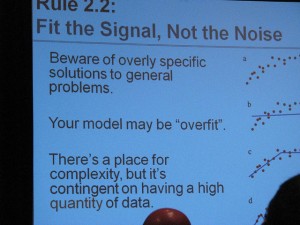Saturday the New York Times published on its front page an article by reporter Jeremy W. Peters about Republican Senator Rand Paul criticizing his party for backing laws that make it harder for some people to vote by requiring forms of identification they may not have. Unquestionably, this was news. The Times report included this paragraph:
Few issues ignite such passion among the base of both parties. Democrats argue that the laws are intended to keep poor voters away from the polls because they often have difficulty obtaining identification. Republicans contend cheating is rife in today’s elections.
Excuse me: Would you happen to know, New York Times, whether fraud at the polls is “rife in today’s elections?” Is that something I should expect you to know, seeing as you are the high-end product in the national news marketplace? Or is Democrats argue/Republicans contend/We have no idea a good enough standard, and it is my expectations that are out of scale?
In this article, at least, the Times does not know whether cheating is rife in today’s elections. But it knows of a passion for polarizing the issue among the bases of both parties. This helps makes it a classic in the “he said, she said” genre.
Look, we have no idea who’s right. How would we? Figure it out for yourselves! Don’t be asking us to sort out what’s real from what’s fiction. We’re just New York Times journalists. We don’t do “there’s no basis for that.” We do “Republicans contend…”
I’m satirizing but to make a point: this standard isn’t good enough. At least since the launch of Politifact.com in 2007 — which does do “sorry, there’s no basis for that,” sometimes — it’s been made clear to mainstream practitioners in the U.S. that the classic forms of he said, she said are not so much a “sin” against high practice as an increasingly crappy level of service for what is supposed to be an upscale product: New York Times reporting. If you can say (reliably) there’s no evidence for… and you don’t, how well have you done by Times authority?
Here I hand the mic to a fellow blogger of this one sad but (we think) telling paragraph, Felix Salmon, now of Fusion. Felix broke it down proposition by proposition: False equivalency in the NYT. (“How Jeremy Peters’s voter ID reporting is even more wrong than you think.”) I urge you to read his post and come back to this one.
Meanwhile, this report from — hey! — the New York Times in 2007 testifies:
Five years after the Bush administration began a crackdown on voter fraud, the Justice Department has turned up virtually no evidence of any organized effort to skew federal elections, according to court records and interviews.
Also this from Politifact/Georgia rating as “mostly true” the claim that in-person voter fraud is a very rare phenomenon, so rare that “only 10 cases of in-person voter fraud have been proven nationally.”
Or this in 2013 from Politifact/Texas: “By our reading of the attorney general’s records, 18 instances of voter fraud have been confirmed in Texas since 2002.” That’s an average of 1.6 cases per year. In a state where more than a million votes are cast in an off year. Rife?
Or read what law professor and election law scholar Richard L. Hasen, author of The Voting Wars: From Florida 2000 to the Next Election Meltdown (Yale University Press: 2012) has to say on how “rife” it is:
Federal Judge Lynn Adelman looked at the evidence from Wisconsin and reached a conclusion unsurprising to those of us who study how elections are run. “Virtually no voter impersonation occurs in Wisconsin,” Adelman wrote, “and it is exceedingly unlikely that voter impersonation will become a problem in Wisconsin in the foreseeable future.”
Wisconsin is not alone in lacking such evidence. When the United States Supreme Court considered the constitutionality of Indiana’s voter ID law in 2008, the state conceded there was no evidence, ever, of impersonation fraud in the entire state.
As Salmon says, you don’t have to pretend that there is a lot of fraud to be in favor of more controls. “In fact, you don’t even need to think that cheating exists in order to support such measures. It’s entirely rational to support a voter ID law even if cheating is rare or nonexistent, on the grounds that cheating is just too easy right now and that you want to make it harder.”
So what is that exceedingly crappy paragraph doing there on the newspaper-of-record’s front page? Salmon says it’s laziness. (“He-said-she-said is so easy, for a journalist on deadline, that both journalists and editors tend not to really thinking about exactly what they’re saying.”) Certainly ease-of-use is part of the device’s fading delights.
Here’s how I described the appeal of he said, she said in 2009. It makes the story writable on deadline when you don’t know enough to sort things out. In a “he said, she said” classic:
* No real attempt is made to assess clashing truth claims in the story, even though they are in some sense the reason for the story. (Under the “conflict makes news” test.)
* The means for assessment do exist, so it’s possible to exert a factual check on some of the claims, but for whatever reason the report declines to make use of them.
* The symmetry of two sides making opposite claims puts the reporter [and the user] in the middle between polarized extremes.
I question whether that between-two-extremes territory, the “you figure it out/for us partisan polarization rules” space is valuable turf in the news business. I doubt that it’s “safe,” either, if you mean by safe: won’t do the brand harm. I think it’s likely to corrode trust over time. A conventional explanation for he said, she said says: it may be lazy or incomplete, but it is also a safe middle ground place to land so you can get the damn paper out!
But it’s not that safe. Democrats argue/Republicans contend/We have No Idea… increasingly won’t cut it for the Times, or its competitors like the FT, the Wall Street Journal, the Washington Post, Bloomberg. The upscale, high-information readers the Times wants to charge more money to, the core loyalists who are being asked to finance more of the operation— these users are increasingly likely to know about various preponderance-of-evidence calls independent of whether the Times knows enough to include that review in its reporting. When this kind of reader comes upon he said, she said reporting on a big story where it’s CONTENTS UNDER PRESSURE, as with the right to vote: bad moment for the Times brand.
My sense: What was acceptably lame under market conditions that Bill Keller began with is a more corrosive practice today. I think The Masthead knows it. This is one of the reasons they created the Upshot, where preponderance of evidence, not a summary of partisan talking points, is supposed to be the baseline practice.
A good way to prove it: The Upshot looks at the evidence and makes a call on “Republicans contend cheating is rife in today’s elections.”


